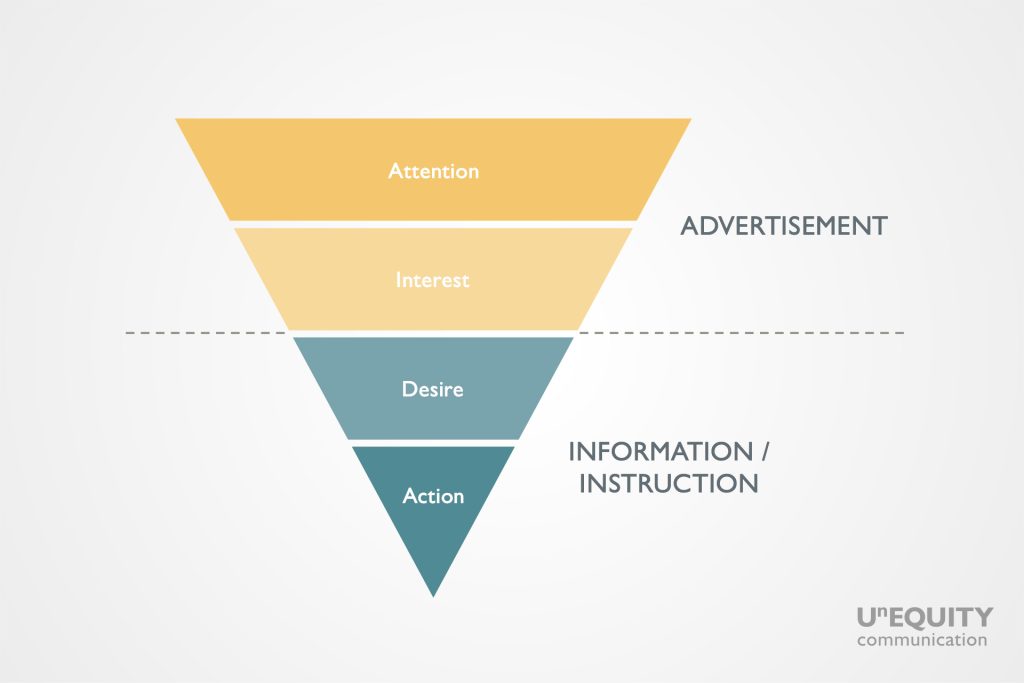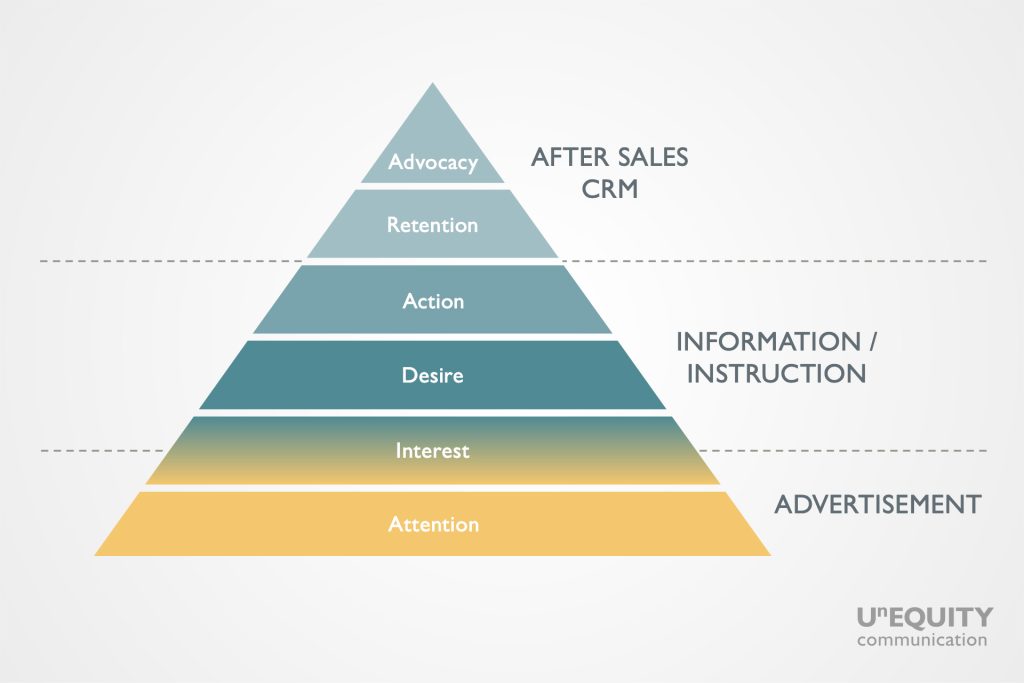
AIDA – no, we aren’t talking about operas
AIDA is one of Giuseppe Verdi’s most beloved operas. Set in ancient Egypt, the tragic story of two royal daughters premiered in Cairo to celebrate the opening of the Suez Canal in 1871. It remains one of the most popular classical works, but that’s NOT what we are talking about today.
Instead, we are talking about the magic formula Attention – Interest – Desire – Action, the gold standard marketing concept. Structured like a pyramid, it defines the four phases a customer goes through before making a purchase decision.
4 steps to become a customer
Although it is most commonly used in marketing, the AIDA concept can be used for all other communication, for example, in Human Resources.
Step 1 – Attention
The message we want to send must first attract the attention of the target audience. This can be a catchy slogan, an eye-catching series of images, an animation, or something else entirely.
Step 2 – Interest
In this stage, the focus is on the content. What are we talking about; what is the topic? It is critical that we convey the core message—the benefit for the recipient, i.e., we answer the question, “What is in it for me?” The content of these first two stages is advertising. Customers are encouraged to take an interest in the product or service.

Step 3 – Desire
The message has been received. Now we need to awaken a need or a desire, so the customer says, “I want this too!” Here’s where we provide additional information, for instance, real-life examples and further benefits.
Step 4 – Action
Now, the decision becomes action, as the customer says, “I’m going to do this now!” The content mainly provides information and instructions on the best and quickest way to reach your goal.
In the end, when it comes to professional communication, there’s one major goal. Explain to the target audience what they stand to gain for themselves, their family, and their lives. For decisions about services and products, the AIDA pyramid ends here. For internal communication, however, this is the start of a long-term relationship between the provider and the recipient—the Internal Customer Relationship Management.
AIDA as the start of the Customer Journey – Real-life examples: Benefits
Let’s take a look at a real-life example, in this case, an attractive Benefits Package. Employees know the benefits their employer offers, have all the relevant information, and have decided to take advantage of the benefits according to their specific needs. They have most likely gone through the entire AIDA system without noticing it, and have gained their first experience of the benefits. Now, the employer wants to ensure that the benefits are used and appreciated in the long term. In the best case, word-of-mouth spreads positive employee experiences throughout the workforce almost automatically. Now, we add two steps to AIDA. Retention (user loyalty or employee loyalty) and Advocacy (committing to something or making recommendations).
The 1st additional step – Retention
In this stage, we want users to continue taking advantage of the Benefits Package and feel their needs are being met. They should feel satisfied with their benefits in the long term, and value them as a voluntary contribution from their employer. And they should feel a sense of connection with the company, now and in the future.
This is the time to ask users for their feedback. How did you find the Benefits Package? Was it easy to access the relevant information—via online platforms, human interactions, or even AI? Could we offer additional features, tailored to the employees’ current situation in life, with automated and individualized recommendations? Is the Benefits Package aligned with our corporate culture?
Using qualified user feedback, we can better classify and evaluate the benefits offered, providing Benefits Managers with greater clarity and transparency on planned targets, and the need for adjustments.
When the benefits offered are optimized for the needs of the target audience, are well known within the company, and employees regularly take advantage of them, we can maximize employee loyalty.
The 2nd additional, and the highest, step – Advocacy
What every organization that provides benefits wants – employees who are the greatest ambassadors of the Benefits Package. This has a much more significant impact than any beautifully designed brochure. People who speak from experience are the most reliable sources.
When we share a user review, or a colleague communicates their positive experience, this is generally considered more credible than any advertising message. The most important thing at this stage is that the relevant forums and communication channels (e.g., Viva Engage) are set up, and the rules of use are clear to everyone—such as using constructive criticism for less positive experiences. It is advisable to provide a short guide for all testimonials. You can find some examples of successful testimonial campaigns on our Projects page.

The Customer Journey in Internal Communication
For this project to succeed, the internal company ambassadors should be supported on their journey (see Employee Experience and Employee Journey.)
This is particularly important for the Benefits Package as a deciding factor for employee satisfaction, and should be used throughout the entire Total Rewards system, and beyond.
To summarize, the AIDA concept (including communication) applies in all areas where there is interaction between employer and employees, right through to the employees’ private lives.
It is only the start of a path that continues in the employee experience along the employee journey.
What’s the difference?
User Experience / User Journey
The perception and experiences of the user of the product or service (e.g., software)
Customer Experience / Customer Journey
The perception and experiences of a customer with a product or service (e.g., a device)
Employee Experience / Employee Journey
The perception and experiences of an employee with the company and its provisions over the course of the employment relationship.
Conclusion
The AIDA concept is a gateway for the relationship between customers and suppliers. Communication must be understood and undertaken as a two-way system to achieve a lasting win-win situation. With this, companies can provide better products and services that meet the needs of ever more committed users, so that everyone profits from the resulting amplification.
In our blog on UX/UE, we take a look at the concepts of User Experience, and the Employee Experience. We will explore the individual steps of the Employee Journey in our next post in our Jargon Jungle series.
Are you currently working on such topics and are looking to position your company for the future? Then talk to us. We won’t sing elaborate arias from AIDA, but we have mastered the art of internal communication.
- This article was published on
What can we do for you?
If you are looking for a reliable partner, get in touch with us.
As a creative communications agency with expertise in consulting in the HR sector — also known as People & Culture, Development, or Organization — we have been delivering professional internal communication for global companies since 2011. We specialize in the communication of Total Rewards.
Using effective communication strategies, creative media, and clear and captivating content, we manage projects and campaigns with a lasting impact — motivated, loyal employees and successful organizations.
We lead people projects to success through communication.

Your contact person
Share this page directly: